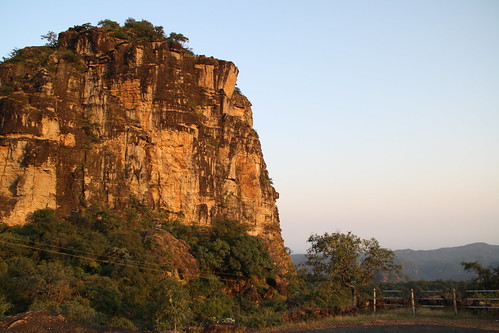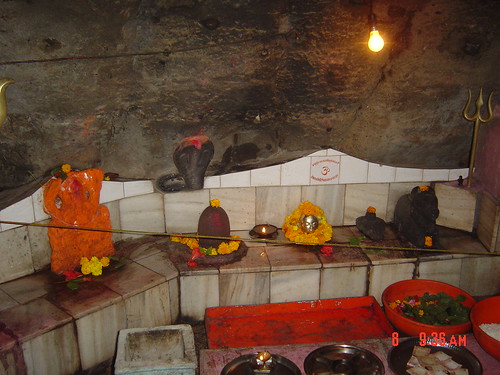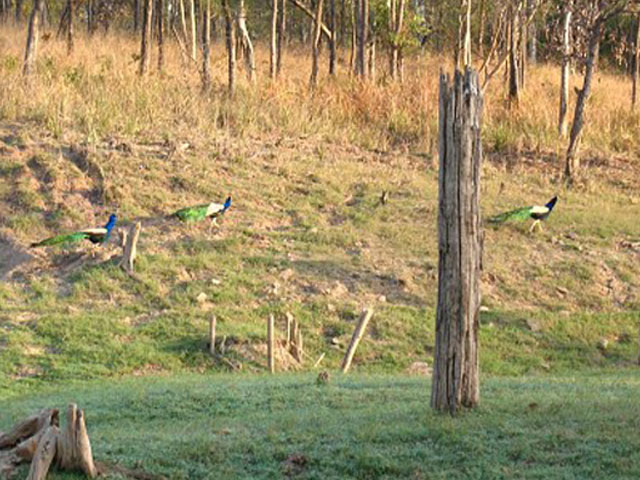How to reach here:
By Air: Bhopal airport is the nearest airport to Pachmarhi, which is about 195 km away.
By Rail: Pipariya is the nearest railway station, which is 47 km away from Pachmarhi. Pipariya is on the main line to Mumbai – Howrah and most of the major trains stop at this junction. Pipariya is connected to major Indian cities like Mumbai(Mahanagari Exp), Kolkata (Kolkata Mail), Chennai, (Gangakaveri Exp), Bangalore (Sangha Mitra Ex) and Delhi (Jbp Ndls Sup Ex).
Best time to visit: October to March
Languages spoken: Hindi
Must eat: Pilaf with Peas and Carrots, Kusli, Jalebi, Cashew Burfi.
Famous Restaurants: Kolkata corner, Chunmun.
Places you must visit:
Priyadarshini (Forsyth Point), a vantage viewing point marks the place from where Pachmarhi was discovered by Captain Forsyth in 1857. The British developed Pachmarhi as a resort and their influence is embodied in its churches and colonial architecture.


Jamuna Prapat (Bee Fall) is a spectacular fall in the stream which provides drinking water to Pachmarhi. The bathing pools above the fall are very popular.


Handi Koh is a V-shaped, 300 feet deep ravine, which has been created by two gigantic hills. As per legend, this is the site from where a British officer, named Handi, committed suicide by jumping into the ravine.

Apsara Vihar (Fairy Pool) is naturally formed pool with a beautiful and small waterfall. Fondly known as Fairy Pool, Apsara Vihar is situated in the hills of Pachmarhi near Pandava Caves. The 30 feet high waterfall forms a shallow pool, which is a popular picnic spot among locals as well as tourists. Water of the pool is perfect for swimming and diving.According to a legend, English ladies used to bathe in this pool during the British rule in India. As the English ladies wore white clothes while bathing, locals thought them to be fairies and hence named the pool as Apsara Vihar or Fairy Pool.


Rajat Prapat (Silver Fall) is a waterfall located near Apsara Vihar. Water of this fall plunges from a height of about 350 feet. Popularly known as Silver Falls, this fall is best viewed during the rainy season.

Irene Pool is a bathing pool, which was discovered by Irene Bose, wife of Justice Vivian Bose. On the upstream there is a cave from which the stream goes underground and then descends in the form waterfall.

Jalawataran (DuchessFalls) is a beautiful waterfall, which is also known as Jalwataran. Tourists can reach this waterfall by trekking around 4 km from the base. Monsoon season is the ideal time to visit this waterfall, when water flow is high.
Sunder Kund (Saunder's Pool) is a huge rocky pool that is excellent for a refreshing swim.

Within the Satpura Hills at a height of 1363 meters is the scenic Mahadeo hill, known for the famed Lord Shiva temple. This ancient Shiva temple is known for an imposing statue and a massive shivalinga. The hill has steep gorges and is regarded as a holy place for eons. One of the cave has panoramic cave paintings and a beautiful pond for religious dips. Thousands of devotees visit the shrine on Mahashivratri.

Chhota Mahadeo is revered as a sacred spot, this is a narrow point in the valley with rocks overhanging a stream and a spring from where water cascades down.


Chauragarh temple is a popular pilgrimage centre, which is situated at an altitude of 1326 metre. It basically comprises a temple dedicated to Lord Shiva, which is located 4 km away, at the end of a steep climb of 1300 steps from Mahadev. Devotees have to make a strenuous climb carrying a trishul as an offering to Lord Shiva. This ritual of carrying three to four quintal heavy trishul to the shrine is prominent during Shivaratri. At the shrine, there is a Dharmashala where devotees can stay and relax.

Jata Shankar Cave is a prominent religious destination, visited by tourists year-round. As per mythological belief, Lord Shiva hid himself inside the cave, due to the fear of demon Bhasmasur. Inside the cave there are naturally formed 108 Shiva lingam. Water in the cave flows from an unknown point as no one has ever seen or reached that starting point. This stream of water is popularly known as 'Gupt Ganga'.It is believed that the Jambu Dwip stream originates from cave. Idols of Lord Shankar, Goddess Parvati and Shiva lingam are enshrined at a platform on the upper part of the cave.




Dhoopgarh, which was originally known as Harvatsa Kot, is the highest point in the Satpura mountain ranges. This popular spot is known for viewing sunrise and sunset. It is located at 4429 feet above the mean sea level and offers a beautiful view of the surroundings.



Pandava Caves, located on a hillock in Pachmarhi, are believed to have been a shelter of the Pandavas during their period of exile. These renowned five caves are carved out of sandstone rock. Amongst all the five caves, 'Draupadi Kuti' is the cleanest and well-ventilated. Bhim Kothari, which was the cave of Bhima, toughest of five brothers, is the darkest cave.



Bade Mahadev is a 60 feet long cave in which deities of Lord Brahma, Lord Vishnu, Lord Mahesh and Lord Ganesha have been enshrined. As per a mythological belief, Lord Vishnu defeated the demon King Bhasmasur in this cave by taking the form of Mohini.Bade Mahadev is a 60 feet long cave in which deities of Lord Brahma, Lord Vishnu, Lord Mahesh and Lord Ganesha have been enshrined. As per a mythological belief, Lord Vishnu defeated the demon King Bhasmasur in this cave by taking the form of Mohini.


Satpura National Park is located in the Satpura ranges of the district of Hoshangabad of Madhya Pradesh. Located close to Pachmarhi, this national park was established in 1981 and covers an area of around 524 sq. km. This national park consists of sandstone peaks, narrow gorges, ravines and dense forests.Being part of a unique ecosystem, this park is home to tiger, leopard, sambhar, chital, bhedki, nilgai and four-horned antelope. Tourists can also spot chinkara, bison (gour), wild boar, wild dog, bear, black buck and flying squirrel in this park. Besides rich diversity of fauna, flora like sal, teak, tendu, aonla, mahua, bel, bamboo and medicinal plants can also be seen in the park.


Christ Church is one of the religious places in Pachmarhi, which was built by Britishers in 1875. The glass panes adorning the walls and rear of the altar were imported from Europe. This church has a hemispherical dome on top with its ribs ending in faces of angels. Moreover, the Nave of the church is not supported by any pillar.

Bison Lodge is the oldest house in the town of Pachmarhi that was constructed in 1862. This house serves as a museum, which is dedicated to Captain Forsyth, who is considered to be the founder of Pachmarhi.The museum houses several pictures, models, maps, graphs and samples of the flora and fauna on the display. This museum also has an open-air theatre that shows documentaries and presentations on wildlife.

Lanjee Giri is a popular hill, which scales from both east and west. This hill is ideal for rock-climbing and is hence, frequented by adventure seekers. An underground passage leading down the northern face is located near the western summit of the hill.

Harper's Cave is one of the popular cave shelters, which is named after one of its paintings, in which a person is seen playing a harp sitting close to the Jata Shankar Shrine.

Gupt Mahadev is a 40 feet long cave, in which idols of Lord Ganesha and Shiva lingam have been enshrined. The path that leads to Gupt Mahadev cave goes from inside the Bade Mahadev. This narrow path can be passed only by eight people at a time. At the entrance of the cave, an idol of Lord Hanuman has been enshrined.



Hi there, what a good travelogue.
ReplyDeleteI've just come back from a trip to India and spent 3 days looking round Pachmarhi. Your photos have come out really well and are a good reminder of my trip.
Thank you so much Colin. I am glad my blog could rekindle your trip memories.
DeleteYes this is really a beautiful place ,thanks to share this story and pics.
ReplyDelete